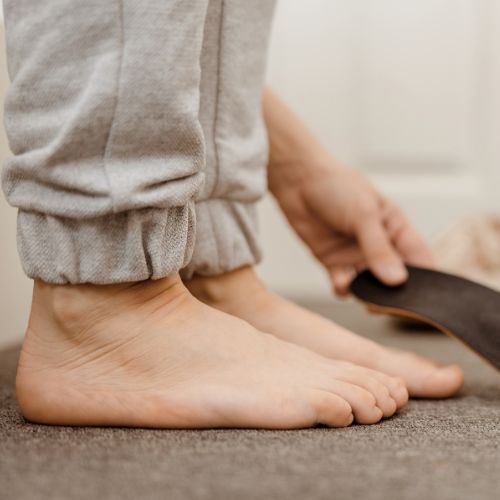Flat feet, also known as fallen arches, is a common condition in which the arches of the feet appear to be flattened, causing the entire foot to come into contact with the ground while standing. This condition can lead to discomfort, and pain, and even affect the body’s overall alignment. In this comprehensive article, we will explore the causes and symptoms of flat feet, along with various strategies and treatments to find relief and manage this condition effectively.

Understanding Flat Feet and Fallen Arches
- Flat feet occur when the arches of the feet fail to develop during childhood or become weakened and collapse over time.
- Fallen arches can be congenital (present from birth) or acquired due to factors such as injury, age, or certain medical conditions.
Causes of Flat Feet
- Genetics: Flat feet can be inherited from one or both parents.
- Footwear: Prolonged use of unsupportive or ill-fitting shoes can contribute to the development of flat feet.
- Injury: Trauma or damage to the foot’s ligaments and tendons can lead to fallen arches.
- Aging: The arches may weaken and flatten as part of the aging process.
- Obesity: Excess body weight can put added strain on the feet, leading to the development of flat feet.
- Medical Conditions: Conditions such as arthritis, diabetes, or nerve-related disorders can contribute to flat feet.
Common Symptoms of Flat Feet
- Pain or discomfort in the arch, heel, or ankle area.
- Tired or achy feet after standing or walking for extended periods.
- Overpronation: The feet roll inward excessively while walking or running.
- Difficulty finding comfortable footwear that provides adequate support.
- Foot and leg fatigue or cramping.
Diagnosis of Flat Feet
- A healthcare professional, such as a podiatrist or orthopedic specialist, can diagnose flat feet through a physical examination and medical history review.
- Additional tests, such as imaging studies or gait analysis, may be conducted to assess the severity and underlying causes of the condition.
Non-Surgical Treatment Options
- Supportive Footwear: Wearing shoes with proper arch support and cushioning can alleviate discomfort and provide relief.
- Orthotic Inserts: Custom-made or over-the-counter arch supports can help correct foot alignment and distribute pressure more evenly.
- Physical Therapy: Targeted exercises and stretches can strengthen foot muscles and improve gait mechanics.
- Rest and Ice: Resting the feet and applying ice can reduce inflammation and ease pain.
- Weight Management: Maintaining a healthy weight can lessen the strain on the feet.
Lifestyle Modifications
- Avoid high-impact activities that may exacerbate flat feet symptoms.
- Practice foot-strengthening exercises regularly to improve foot function.
- Opt for low-impact exercises like swimming or cycling, which are gentler on the feet.
Surgical Intervention
- In severe cases or when conservative treatments fail to provide relief, surgical options may be considered.
- Surgical procedures aim to reconstruct the foot’s arch and restore proper alignment.
Preventing Flat Feet
- Encourage proper foot development in children by providing supportive shoes from an early age.
- Avoid wearing high heels or unsupportive shoes for extended periods.
- Maintain a healthy weight to reduce the strain on the feet.
- Practice foot exercises and stretches regularly to maintain foot strength and flexibility.
Addressing Fallen Arches in Athletes
- Athletes with flat feet should consult a sports medicine professional or podiatrist for specialized treatment options.
- Custom orthotics or shoe inserts tailored to their sport and foot mechanics can help reduce the risk of injuries and enhance performance.
Footwear Tips for Flat Feet
- Choose shoes with good arch support and cushioning to reduce strain on the feet.
- Look for brands that offer shoes specifically designed for flat feet or fallen arches.
- Avoid shoes with high heels or minimal support.
Complementary Therapies
- Some individuals find relief from flat feet symptoms through complementary therapies such as acupuncture or chiropractic care.
- These therapies can help address musculoskeletal imbalances and improve overall body alignment.
Caring for Flat Feet in Children
- Monitor your child’s foot development, especially if flat feet run in the family.
- Encourage proper footwear and foot-strengthening exercises during childhood.
When to Seek Medical Attention
- If flat feet cause persistent pain or interfere with daily activities, consult a healthcare professional.
- Seek immediate medical attention if there is sudden severe foot pain or injury.
Conclusion
Dealing with flat feet and fallen arches can be challenging, but with proper care, support, and treatment, relief is possible. Understanding the causes, symptoms, and available treatment options can empower individuals with flat feet to take proactive steps towards managing the condition effectively. Whether through supportive footwear, orthotic inserts, physical therapy, or surgical intervention, finding relief for flat feet can significantly improve overall foot health and enhance the quality of life. Remember to consult a healthcare professional for personalized guidance and tailored treatment plans that suit individual needs.
